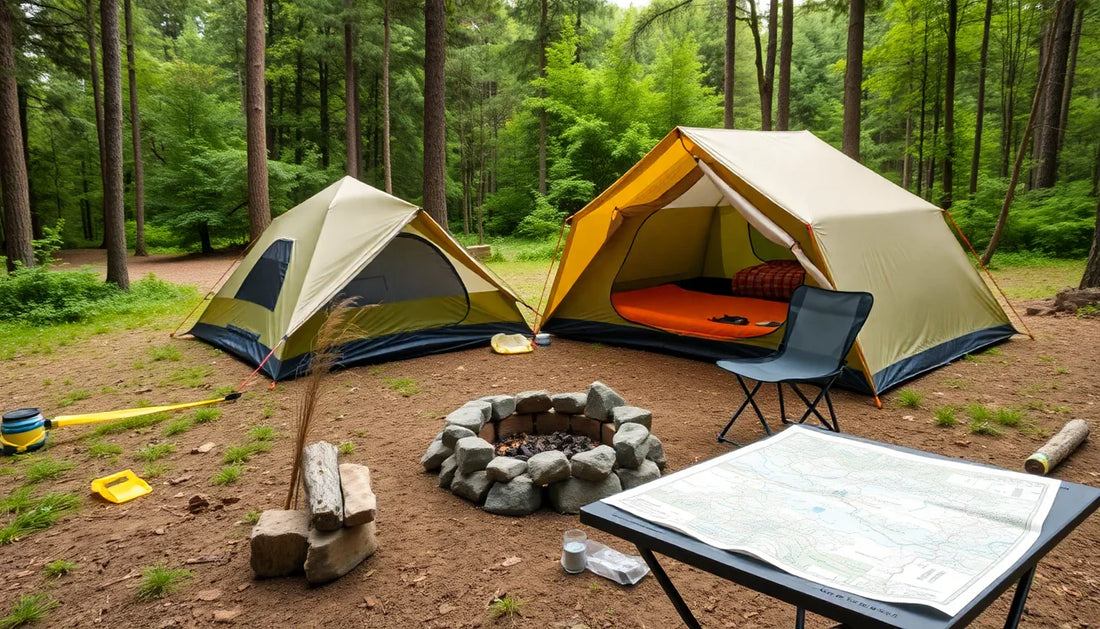
How to Create the Perfect Campsite Layout for Comfort and Safety
Share
Embarking on a camping adventure is an exhilarating way to immerse yourself in the great outdoors and reconnect with nature. However, the success of your trip often hinges on how well you plan and organize your campsite. A thoughtfully designed campsite layout can make all the difference in ensuring your outdoor experience is both comfortable and safe.
At GlowCamp, we believe that the key to a truly memorable camping trip lies in creating an outdoor living space that caters to your needs and preferences. Our curated collection of functional camping gear is designed to help you achieve just that - a campsite that feels like a home away from home.
In this comprehensive guide, we'll walk you through the essential steps to designing the perfect campsite layout, from choosing the right location to arranging your gear for maximum efficiency and safety. Whether you're a seasoned camper or a newcomer to the great outdoors, these tips will help you create a campsite that's both practical and enjoyable.
Choosing the Right Campsite Location
The foundation of a well-designed campsite begins with selecting the right location. When scouting for the perfect spot, consider the following factors:
Terrain Assessment
Look for a relatively flat, level area that will provide a stable and comfortable surface for your tent and other gear. Avoid steep slopes or uneven ground, as these can lead to discomfort and potential safety hazards.
Natural Protection
Seek out a campsite that offers natural protection from the elements, such as trees or rock formations that can shield you from wind, rain, or direct sunlight. This will help create a more comfortable and sheltered living space.
Proximity to Water and Facilities
While you'll want to be close enough to water sources and any necessary facilities, it's important to maintain a safe distance to avoid potential contamination or disturbance. Aim for a campsite that's within a reasonable walking distance to these amenities.
Tent Placement Strategies
The placement of your tent is crucial for ensuring a comfortable and safe sleeping environment. Consider the following tips:
Ground Levelness and Drainage
Choose a spot that is relatively flat and well-drained to prevent water accumulation during rain or snowmelt. This will help keep your tent and sleeping area dry and comfortable.
Wind Direction
Situate your tent so that the entrance faces away from the prevailing wind direction. This will help minimize drafts and keep the interior of your tent more sheltered.
Distance from Fire Pit and Cooking Area
Maintain a safe distance between your tent and any fire pits or cooking areas, typically at least 15 feet (4.5 meters) or more. This will help prevent accidental fires and ensure your sleeping area remains smoke-free.
Campsite Kitchen and Cooking Zone Setup
The campsite kitchen is the heart of your outdoor living space, so it's important to organize it for maximum efficiency and safety.
Efficient Workspace Organization
Designate a specific area for your camp kitchen, and arrange your cooking equipment, utensils, and food storage in a logical, easy-to-access manner. This will streamline your meal preparation and cleanup processes.
Safe Cooking Equipment Placement
Position your camp stove, grill, or fire pit in a well-ventilated area, away from overhanging branches or other flammable materials. Ensure that the cooking zone is situated a safe distance from your tent and other high-traffic areas.
Food Storage and Preparation Tips
Invest in bear-proof containers or hang your food from a tree to keep it secure from wildlife. Designate a separate area for food preparation to maintain a clean and organized cooking space.
Fire Pit and Gathering Area Design
The fire pit and surrounding gathering area are the social hubs of your campsite, so it's important to design them with both comfort and safety in mind.
Safe Fire Pit Location
Choose a spot for your fire pit that is at least 15 feet (4.5 meters) away from your tent, trees, and other flammable materials. Ensure that the ground is clear of any debris or vegetation that could easily catch fire.
Seating Arrangement
Arrange seating, such as camp chairs or benches, in a semicircle around the fire pit to create a cozy and inviting gathering space. This layout encourages conversation and interaction among your group.
Emergency Fire Management
Keep a shovel, water, and a fire extinguisher nearby to quickly extinguish the fire if necessary. Familiarize yourself with the proper fire management techniques to ensure the safety of your campsite.
Safety and Organizational Essentials
Maintaining a well-organized and safe campsite is crucial for a successful outdoor adventure. Consider the following tips:
Clear Pathways
Establish clear pathways between different zones of your campsite, such as the tent area, kitchen, and fire pit. This will help prevent tripping hazards and ensure smooth movement throughout your outdoor living space.
Equipment Storage
Designate specific areas for storing your camping gear, such as your backpacks, coolers, and other equipment. This will help keep your campsite tidy and reduce the risk of misplacing or damaging your belongings.
First Aid and Emergency Kit Placement
Ensure that your first aid kit and any emergency supplies are easily accessible and stored in a central location, such as near your camp kitchen or in a designated gear storage area.
Family-Friendly Campsite Layout Considerations
If you're camping with children, it's essential to design your campsite with their safety and comfort in mind.
Separate Activity Zones
Create distinct areas for different activities, such as a play area for the kids, a quiet zone for relaxation, and a communal gathering space. This will help minimize disruptions and ensure everyone can enjoy the campsite to the fullest.
Child Safety Measures
Implement safety measures, such as creating a barrier around the fire pit or designating a specific area for children to play, to ensure their well-being throughout your outdoor adventure.
Comfort and Convenience
Prioritize features that will make your family's camping experience more comfortable, such as a shaded area for napping or a designated spot for setting up a portable toilet or changing station.
Conclusion
Designing the perfect campsite layout is an art that requires careful planning and attention to detail. By considering the factors we've outlined in this guide, you'll be well on your way to creating an outdoor living space that is both comfortable and safe, allowing you to fully immerse yourself in the beauty and serenity of the great outdoors.
At GlowCamp, we're dedicated to providing you with the tools and resources you need to make the most of your camping adventures. Explore our curated collection of functional camping gear and let us help you elevate your outdoor experience.
